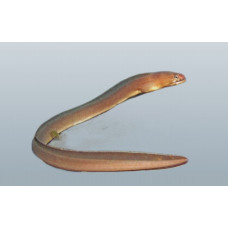Latin name
Gymnothorax angusticauda
Other name
Gymnothorax angusticauda
Identification
The Narrowtail moray was first named by Weber and de Beaufort in 1916. They have 143 to 147 vertebrae. The body is moderately elongated. The head and jaws are moderately sized, with the jaws fully clenched. Eyes well developed, about midway up the upper jaw. Gill openings nearly horizontal, medially lateral. The teeth of the upper jaw are arranged in a single row, about 7-14, similar in shape to the intermandibular teeth. The teeth of the lower jaw are arranged in a single row, similar in shape to the teeth of the upper jaw, about 7-19 teeth on each side. Coulter with 3-6 teeth in a single row.
Features of fish fins
The dorsal fin begins just before the gill openings, and the tail is relatively thin.
Fish colouring
The body is medium to light brown or brownish tan. The muzzle and lower jaw are darker, the belly is sometimes white. Pores on head with conspicuous white patches, nostrils white. Fin with narrow pale edge. Iris yellow.
Distribution
Widespread in the Pacific and Indian Oceans, the Red Sea and around Indonesia.
Habitat
Tropical marine bottom dwellers. Depth range from 15 to 200 meters.
Size
Maximum length 50.3 cm.
Behavior
They usually congregate in groups on sandy and muddy bottoms.
Food and feeding habits
Narrowtail morays feed on zoobenthos.
Reproduction
Development takes place through metamorphosis: from the egg hatches a leaf-shaped transparent larva, not at all like an adult fish. In the future, moray eels also undergo a sexual transformation, changing from males to females.
Fishing
There is a small commercial fishery for this species.
Relationship with a person
Harmless.
| Classification | |
| Phylum | Chordata |
| Class | Actinopterygii |
| Squad | Anguilliformes |
| Family | Muraenidae |
| Genus | Gymnothorax |
| Species | G. angusticauda |
| Features | |
| Conservation status | Data deficient |
| Habitat | Bottom |
| Life span, years | No information |
| Maximum body weight, kg | No information |
| Maximum length, cm | 50,3 |
| Sailing speed, m/s | No information |
| Threat to people | Not edible |
| Way of eating | Planktonophage |
Narrowtail moray
Tags: narrowtail moray

